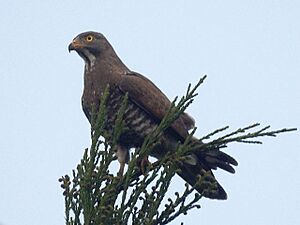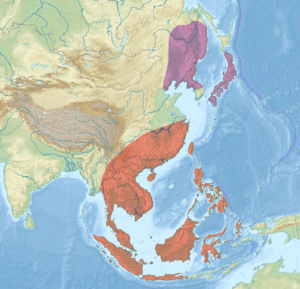Grey-faced buzzard facts for kids
Quick facts for kids Grey-faced buzzard |
|
|---|---|
 |
|
| Conservation status | |
| Scientific classification | |
| Genus: |
Butastur
|
| Species: |
indicus
|
 |
|
| Violet: breeding; Red: non-breeding | |
The grey-faced buzzard (Butastur indicus) is a fascinating Asian bird of prey. It's a small raptor, usually about 41 to 46 centimeters (16-18 inches) long. These birds spend their breeding season in places like Manchuria, Korea, and Japan. When winter arrives, they fly south to warmer areas in South-east Asia.
Grey-faced buzzards prefer open land. They hunt and eat lizards, small mammals, and large insects.
Adult buzzards have a grey head, chest, and neck. They have a white throat and black stripes near their beak. Their back and upper wings are brown. Their underparts and underwings are white with brown bars. Young buzzards are mostly brown with streaks. They have a wide white stripe above their eye and a brown face.
Contents
What's in a Name?
Scientists give every animal a special two-part name. This helps everyone know exactly which animal they are talking about. The grey-faced buzzard was first described in 1788 by a German scientist named Johann Friedrich Gmelin. He gave it the name Falco indicus.
Later, in 1843, another scientist named Brian Houghton Hodgson created a new group, or genus, called Butastur. The grey-faced buzzard is now part of this group. Its full scientific name is Butastur indicus. The word indicus means "Indian" in Latin. There are no different types, or subspecies, of the grey-faced buzzard.
How to Spot a Grey-faced Buzzard
Male and female grey-faced buzzards look very similar. Adult birds have reddish-brown or dark brown feathers on their upper chest. Their lower chest has dark bars. Some buzzards are completely dark brown, which is less common.
These small raptors are usually about 41 to 46 centimeters (16-18 inches) long. Their wings are narrow and pointed. When they fly, their feathers can look thin and see-through. Their tail is ash-brown with horizontal bars. The iris (the colored part of their eye) is bright yellow.
Young buzzards are often less reddish than adults. They have dark brown bars on their belly. Their face and eyes are brown, with a light buff color.
Where They Live and Travel
Most grey-faced buzzards are found in Japan, especially in areas called Satoyama. These areas have many different environments. You can find woodlands, rice fields, streams, and grasslands there.
In places where they breed, these buzzards live in forests. These can be coniferous (like pine trees) or mixed evergreen forests in mountains. They also like forest edges, open fields, meadows, marshes, and farmlands.
Their Amazing Journey: Migration
Grey-faced buzzards use a special path over the ocean to migrate. Strong winds and islands help them fly long distances. They arrive in their breeding areas in Japan from late March to early April. It's thought that males arrive first to protect their territory. Females then join them, and they start building nests and mating.
These buzzards begin their autumn migration south in flocks. This usually happens from late September to mid-October. In Taiwan, they are common visitors in spring and summer. Some even stay for the winter on Lanyu Island.
Like many buzzards, these birds use rising air currents to fly high. This helps them travel great distances while soaring. Taiwan is a big stop on their migration route. Many can be seen flying south in October along the Hengchun Peninsula. In late March and early April, they fly north along the mountains near Taichung and Changhua.
What They Do and How They Live
Hunting for Food
During the breeding season, male buzzards spend most of their day perched. They look for prey from a high spot, usually about 500 meters (1,640 feet) from their nest. They eat frogs, crustaceans (like crabs), lizards, insects, small rodents, and sometimes other birds.
They often perch on a tree or a utility pole next to an open area. This could be a rice field, farmland, or a clearing. From there, they swoop down to catch small animals with their feet. They use a "search and ambush" hunting style. This helps them save energy while still getting enough food.
The buzzards change their diet depending on the season and where they are hunting. Early in the breeding season, they might hunt in rice fields. Later, they move to grassy areas or even woodlands. Their main prey changes with these moves. They might eat more frogs in rice fields. In grassy areas, they catch frogs, small mammals, lizards, snakes, and insects. In woodlands, they mostly catch insects and frogs.
Reproduction and Life Cycle
During the breeding season, the grey-faced buzzard builds a small nest out of sticks. They usually place it high in a tree, often a Japanese tree. In China, nests are often found in thick forests with lots of shrubs and on steep slopes. The nest is lined with soft grass and leaves.
A female buzzard usually lays 3 to 4 white eggs. These eggs have rusty or reddish-brown spots. They breed in eastern China, eastern Russia, and Japan. In winter, they mainly live in Indochina, Malaysia, and the Philippines.
Sometimes, the same nest is used year after year. The female buzzard does most of the egg incubation and caring for the young. Males help out briefly a few times a day. The eggs hatch from late May to early June, about a month after they are laid. The young birds, called nestlings, leave the nest from late June to early July. This is about 35 days after they hatch. The parents feed the fledglings (young birds that can fly) near the nest for about two weeks. After that, the young birds become independent and start to fly long distances.
Buzzards and People
In the past, hunting was a big problem for grey-faced buzzards in Taiwan. People hunted and trapped them for many generations. However, groups like The Wild Bird Society of Japan worked hard to stop this. They helped create laws in Japan that ended the import of raptor skins. This made the demand for grey-faced buzzard skins disappear.
Protecting the Buzzards
In December 2006, grey-faced buzzards were listed as a "Vulnerable" species in Japan. This means they need protection. It can be tricky to protect them because about 90% of their breeding areas are privately owned. Also, 75% of these areas are not legally protected for wildlife.
However, some great efforts are being made. For example, Toyota City in Japan has a plan called "Creating a wood Grey-faced buzzards can live." In the Toyota Natural Observation Woods, they are working to create habitats for frogs, which the buzzards eat. They also maintain the buzzards' hunting grounds by weeding and managing water in old rice fields.
Protecting birds of prey like the grey-faced buzzards needs help from local and regional governments. They can work to maintain entire local ecosystems, even on private land. This helps ensure these amazing birds have a safe place to live and thrive.


